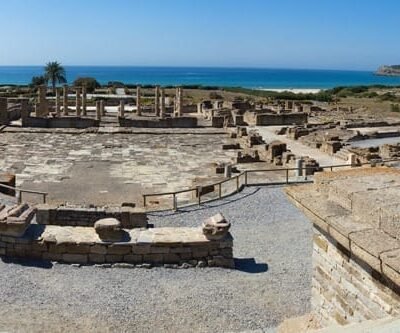Calatrava la Vieja: The Forgotten Fortress where Spain’s First Warrior Monks Forged their Order
The wind sweeps through Calatrava la Vieja, whispering forgotten stories among the sun-scorched stones. By the slow-moving waters of the Guadiana, the fortress stands—silent but unbroken. Once a mighty outpost between Christian and Muslim Spain, it now rests in solitude, bypassed by highways and overlooked by crowds. Unlike the Alhambra or Segovia’s Alcázar, this place holds no grandeur, only the raw echoes of history—waiting for those willing to listen.
Its walls have seen conquest and resilience. Built by the Moors in the 8th century, Calatrava la Vieja controlled the route between Córdoba and Toledo. It fell to Christian hands in the 12th century, only to be reclaimed by the Almohads before it was seized again by a new force—the Order of Calatrava. Here, Spain’s first warrior monks took their oaths, sharpened their swords, and waged a war that would shape an era. The remnants of their chapel still stand, the corroded iron of unearthed weapons a silent testament to their battles.
Yet, why has Calatrava la Vieja been forgotten? Perhaps that is its greatest allure. Here, there are no crowds, no polished exhibits. Instead, you walk freely through time, tracing the footsteps of knights, emirs, and kings—feeling history beneath your hands, where stone and legend still endure.
Post last updated on March 30, 2025 (originally published on March 27, 2025) by Roberta Darie.

- Where Is Calatrava la Vieja and How to Get There?
- What Makes Calatrava la Vieja Special? — The Birthplace of a Military Order
- A Brief but Epic History – From Muslim Stronghold to Christian Powerhouse
- What to See – The Unmissable Highlights of Calatrava la Vieja
- The Outer Walls & Towers – A Fortress Built to Endure
- The Keep (Torre del Homenaje) and the Citadel – The Fortress Within the Fortress
- The Hidden Water Systems – Moorish Ingenuity in a Time of War
- The Church Ruins – A Sacred Shift in Calatrava la Vieja
- Guadiana River Views – A Landscape of War and Peace
- Things to Do near Calatrava la Vieja – More Than Just a Fortress Visit
- Nearby Towns – A Cultural Journey Beyond Calatrava la Vieja
- When to Go & How Long to Stay in Calatrava la Vieja
- Final Thoughts on Calatrava la Vieja – A Journey Back in Time
“Ruins are the cathedrals of time.”
— Nathaniel Hawthorne

Where Is Calatrava la Vieja and How to Get There?
In the vast plains of Castilla-La Mancha, where golden fields stretch beneath an unforgiving sun, the ruins of Calatrava la Vieja stand untouched. This forgotten fortress, once a battleground of empires, lies near the village of Carrión de Calatrava, in Ciudad Real province, about 200 km (ca. 124 miles) south of Madrid and 15 km (ca. 9 miles) from Ciudad Real. Though close to modern roads, it feels a world away from time. There are no ticket booths, no cafés, no guided tours—only the whispers of history carried by the wind and the slow murmur of the Guadiana River, which once gave life to warriors, monks, and merchants alike.
Getting there is part of the adventure. The easiest way is by car. From Ciudad Real, take the N-420 north toward Carrión de Calatrava, passing wheat fields, olive groves, and distant windmills. Five kilometers (ca. 3 miles) before the village, a small sign points toward the archaeological park. Then, as if emerging from history itself, Calatrava la Vieja appears—its crumbling towers still watching over the land. From Madrid, take the A-4 highway toward Andalucía, then connect to local roads.
If traveling by train, the AVE high-speed rail reaches Ciudad Real in just an hour, followed by a 20-minute taxi ride to the site. Public buses don’t reach the ruins. But maybe it is this isolation that has preserved Calatrava la Vieja’s raw authenticity. As you step through the ancient bent entrance, the silence is striking. Suddenly, the past feels closer, the echoes of clashing swords and marching knights almost tangible in the open air.
What Makes Calatrava la Vieja Special? — The Birthplace of a Military Order
Not all ruins are equal. Some fade into the landscape, their stories lost to time. Calatrava la Vieja is different. This fortress wasn’t just another medieval stronghold—it was the cradle of Spain’s first military order, the Order of Calatrava. Long before the imposing Calatrava la Nueva, this riverside citadel was where warrior-monks first took up arms, forever shaping the Reconquista.
Built by the Moors in the 8th century, Calatrava la Vieja controlled the vital Toledo–Córdoba route. In 1147, Christian forces seized it, turning it into a frontier outpost. But there was a problem—too few knights to defend it. Enter Abbot Raymond of Fitero, a Cistercian monk who saw an opportunity. Alongside former soldiers turned monks, he formed a new kind of warrior brotherhood—one that blended monastic discipline with military duty. Thus, the Order of Calatrava was born, proving that faith and warfare could coexist.
However, Calatrava la Vieja was no quiet monastery. It was a battleground. Archaeologists have uncovered thousands of medieval weapons—swords, lances, crossbow bolts, even spiked caltrops—one of the largest such collections in Spain. Its walls bear scars of war, marked by Arabic inscriptions, Gothic chapels, and Islamic-style gates. Here, two civilizations clashed and merged, leaving behind a raw, unfiltered past that still lingers in every crumbling arch and silent stone.
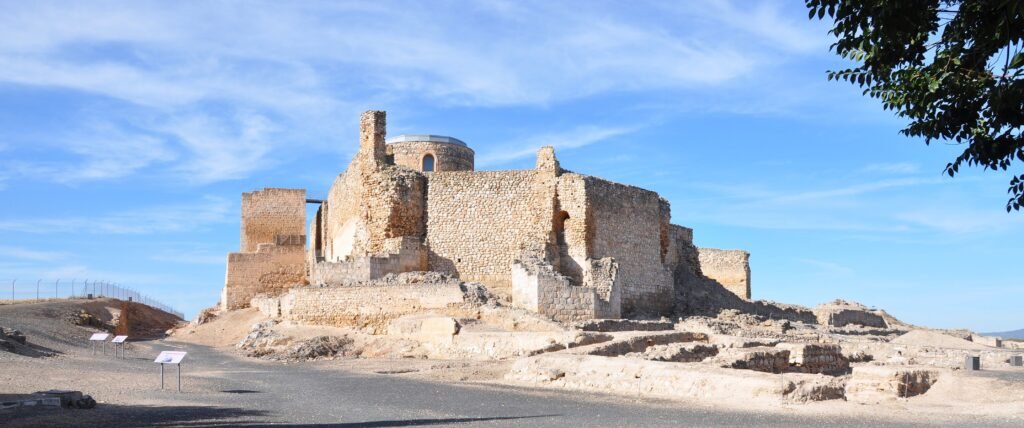
A Brief but Epic History – From Muslim Stronghold to Christian Powerhouse
For centuries, Calatrava la Vieja was more than a fortress—it was a battleground of civilizations. Founded in the 8th century during the Muslim conquest, it was originally Qal’at Rabah, likely named after an Arab noble. Its location along the Guadiana River made it a key military and trade hub, linking Córdoba and Toledo. By the 10th century, it had grown into one of the region’s most populous cities, bustling with merchants, scholars, and soldiers.
Then came war. In 1147, King Alfonso VII of Castile seized the fortress, turning it into the kingdom’s southernmost outpost. He first entrusted it to the Knights Templar, but they soon abandoned it—too isolated, too hard to defend. Then, in an unexpected turn, Abbot Raymond of Fitero, a Cistercian monk, offered to raise an army of warrior-monks. His gamble paid off. In 1158, the Order of Calatrava was born—Spain’s first military order, merging monastic life with the art of war.
But the struggle wasn’t over. In 1195, after the Battle of Alarcos, the Almohads reclaimed Calatrava la Vieja, holding it for nearly two decades. Only after the Christian victory at Las Navas de Tolosa (1212) did the order take it back—for good. However, by 1217, they had moved their headquarters to a new hilltop fortress, Calatrava la Nueva, leaving Calatrava la Vieja to decay. Over time, malaria, abandonment, and time erased the city’s once-thriving life. Yet, its ruins still stand, a silent witness to the battles, faith, and ambition that shaped Spain.

What to See – The Unmissable Highlights of Calatrava la Vieja
Exploring Calatrava la Vieja is like stepping onto the stage of a medieval drama. The ruins are extensive, and a careful wander will reveal the outlines of a whole fortress-city: stout walls and watchtowers, remnants of churches and baths, even engineering marvels hidden beneath your feet.
For more info about opening hours to help you plan your visit, check the castle’s official site. Meanwhile, here are the highlights you shouldn’t miss:
The Outer Walls & Towers – A Fortress Built to Endure
The first thing that strikes you at Calatrava la Vieja is its sheer scale. Enclosed by an elliptical wall spanning 400 by 200 meters (1,312 by 656 feet), this was once one of medieval Spain’s most formidable fortresses. At its peak, 44 towers punctuated its defenses, creating an imposing barrier against invaders. Today, their remnants stand in quiet defiance, their foundations tracing the outline of a lost stronghold.
Some towers reveal sophisticated military engineering. The pentagonal bastions, jutting out like the prow of a ship, were designed to deflect projectiles. The albarrana towers, standing detached from the main wall but connected by bridges, added an extra layer of defense. These were cutting-edge fortifications for their time, making Calatrava la Vieja a model of strategic design.
The most striking feature is the southern main gate, a Moorish “puerta en recodo” (bent entrance). This design forced attackers to turn sharply upon entry, slowing their advance and exposing them to fire from above. Stepping through its arch, you follow the path once taken by Moorish rulers, Christian knights, and military commanders.
Beyond the southern wall, a 10-meter-deep (ca. 33 feet) moat, once fed by the Guadiana River, encircled the fortress. It is Spain’s oldest preserved Islamic moat, a testament to early hydraulic ingenuity. Standing at its edge, you can almost hear the clash of steel, the thud of arrows, the distant roar of battle. Though weathered, the walls of Calatrava la Vieja still whisper their defiant past, reminding visitors that this was once a bastion of power, faith, and war.

The Keep (Torre del Homenaje) and the Citadel – The Fortress Within the Fortress
At the heart of Calatrava la Vieja, within its outer walls, lies the alcázar, the fortress within the fortress. This triangular stronghold, spanning 3,500 m² (37,673 ft²), was the last refuge for defenders and the command center of the Order of Calatrava. Though time has worn down its once-imposing walls, its foundation stones still outline a bastion of power.
The Torre del Homenaje (Keep) was the most formidable structure, serving as the lord’s residence and the site of oath-taking ceremonies. It was likely an albarrana tower, built separately from the main wall but connected by a bridge, ensuring added security. Standing atop the remnants of the citadel, you can still see why they built it here. The Guadiana River winds below, the plains stretch endlessly, and the elevated position allowed for an unparalleled view of the surrounding landscape—ideal for spotting approaching enemies.
Wandering through the alcázar’s ruins, you can distinguish the remnants of barracks, storage rooms, and even the quarters of the Order’s commander. Some walls date back to the 8th–9th centuries, making them among the oldest surviving medieval castle structures in Spain. As you pass through a collapsed doorway, it’s easy to imagine the first warrior-monks of Calatrava deliberating within these walls, their swords at their sides, planning their next move in the Reconquista.
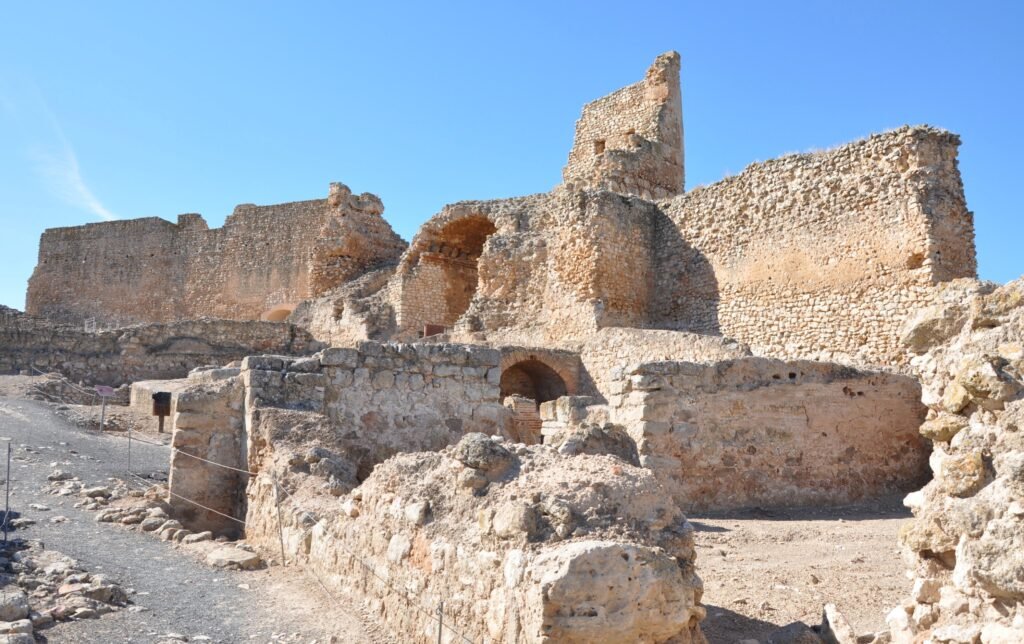
The Hidden Water Systems – Moorish Ingenuity in a Time of War
One of the most remarkable yet overlooked features of Calatrava la Vieja is its ingenious water system, a rarity in medieval fortresses. The Moors, masters of hydraulic engineering, built a coracha, a fortified water channel extending from the castle to the river. By 854 CE, a system of norias (waterwheels) lifted water from the Guadiana, ensuring a constant supply—even during sieges. Most European castles relied on wells or rainwater, but here, water flowed like clockwork.
Even Christian chroniclers marveled at this feat of engineering. Today, near the alcázar, you can trace the coracha’s remnants—a walled passage leading down to where the wheels once stood. Though much remains buried, the very knowledge that an advanced medieval irrigation system lies beneath your feet adds a deeper dimension to the site’s history.
Another feature still intact is the aljibe (cistern), where water from the norias was stored. Built during the fortress’s Islamic phase, it later took on a grimmer purpose. In the 13th century, it became a makeshift dungeon. Captives—Christian and Muslim alike—were imprisoned in its dark recesses, carving charcoal drawings of knights, birds, and Arabic inscriptions into the plastered walls. Though the cistern dungeon is now closed to protect these fragile relics, the knowledge of its existence lingers. Standing above, it is impossible not to wonder: How many warriors spent their final days below, listening to the muffled sounds of war and water above?
Calatrava la Vieja’s ruins tell many stories, but some remain buried—both beneath the earth and within the silence of history.

The Church Ruins – A Sacred Shift in Calatrava la Vieja
Amid the Islamic walls and battle-scarred towers of Calatrava la Vieja, a different kind of ruin tells a quieter story. Near the heart of the fortress, a semicircular foundation of stones marks the apse of a medieval church. A silent witness to the site’s transition from Muslim citadel to Christian stronghold. But this is no ordinary ruin. It is, in fact, the remains of two separate churches, each built by warrior-monks who sought to leave their spiritual mark on this contested land.
The first belonged to the Knights Templar, who briefly held Calatrava la Vieja in the 1150s. Archaeologists have uncovered the foundation of their unfinished church, revealing an unusual dodecagonal (12-sided) apse—a rare design likely inspired by Jerusalem’s Church of the Holy Sepulcher. But the Templars never completed their sanctuary. They abandoned Calatrava before it could be finished, leaving only the ghost of their architectural ambition.
The second church belonged to the Order of Calatrava, which took over the fortress in 1158. This new brotherhood of monk-knights needed a proper chapel for daily prayer and Mass. Traces of their Romanesque-Gothic church remain beside the Templar apse, with sections of vaults and walls dating to the late 12th or early 13th century. It is easy to picture the scene: white-cloaked knights kneeling in candlelight, chanting hymns as the scent of burning iron from the blacksmith’s forge drifts through the fortress.
Standing here, it’s impossible not to reflect on the layers of faith and conquest. Did a mosque once stand on this very spot? Some sources suggest so. Either way, these stones bear witness to centuries of prayer, war, and the ever-changing tides of belief.

Guadiana River Views – A Landscape of War and Peace
No visit to Calatrava la Vieja is complete without taking in the natural beauty that once made this site so strategic. Standing atop the northern wall, you gaze out over the Guadiana River, its waters shimmering under the sun. Today, the river meanders gently, more a quiet stream than an imposing barrier. But in the Middle Ages, it was wider, deeper, and far harder to cross. A natural defense line that shaped the battles and settlements of this land.
From this vantage point, the garrison once watched over the river, scanning for enemy movements and controlling trade routes. Looking out, you can still see why. The Guadiana’s banks, lined with reeds and tamarisk, stretch into the distance, their quiet rustling a reminder of the past. Beyond them, the La Mancha plains unfold like an endless sea, rolling toward Toledo, Córdoba, and Extremadura—regions once fiercely contested by Moors and Christians. It is hard to imagine now, but these very fields were once staging grounds for armies, their camps dotting the landscape, their banners fluttering in the wind.
Yet, the battlefield has long since given way to serenity. In spring, wildflowers burst into color along the banks, while nightingales and dragonflies fill the air. Autumn casts a golden glow over the land, and at sunset, the ruins of Calatrava la Vieja cast long shadows over the river. Photographers will find the perfect shot in the soft morning light, while patient observers might spot storks, herons, or even a lone rabbit darting through the underbrush.
Here, at the edge of history, you can feel the weight of time. Behind you, a fortress built for war. Before you, a landscape that has reclaimed its peace.

Things to Do near Calatrava la Vieja – More Than Just a Fortress Visit
While the ruins of Calatrava la Vieja could easily occupy hours of exploration, the surrounding landscape and nearby attractions offer even more reasons to linger. Whether you enjoy nature, photography, or simply soaking in the tranquil beauty of Castilla-La Mancha, there’s plenty to discover beyond the fortress walls.
Hiking & Nature Walks down the Guadiana River
A dirt path circles the fortress, offering a close look at its imposing walls and dry moat. In spring, wild irises and bright red poppies line the trail, and butterflies drift lazily over the grasses. Follow the path down to the Guadiana, where willows shade the riverbanks. An ideal spot for a quiet picnic or reflection.
For those eager to explore further, the surrounding Campo de Calatrava countryside invites a leisurely ramble. Though mostly flat, the open terrain is home to kestrels, hoopoes, and migratory waterfowl. If birdwatching is your passion, Las Tablas de Daimiel National Park—a wetland haven just 40 minutes north—offers a glimpse of Spain’s most spectacular aquatic birdlife.

Photography to capture Calatrava la Vieja
Calatrava la Vieja is a dream for photographers. Sunrise often brings a mist over the Guadiana, making the ruins seem to rise from a forgotten age. Sunset, meanwhile, drenches the walls in gold, casting long shadows across the plain.
The south gate’s archway makes for a dramatic foreground shot, while the best panoramic view is from the Carretera de la Virgen road. For those seeking detail, the weathered stone textures, arrow slits, and ancient Moorish archways offer stunning close-ups.
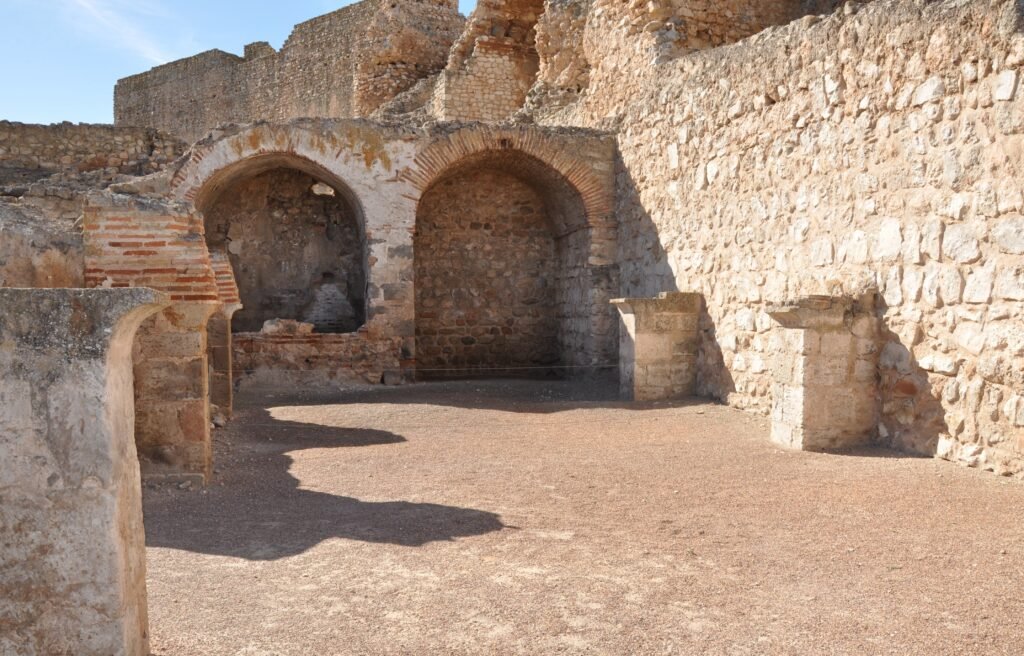
Nearby Towns – A Cultural Journey Beyond Calatrava la Vieja
After wandering the ancient ruins of Calatrava la Vieja, a visit to one of the nearby towns offers a perfect contrast—history meets Baroque splendor, literary legends, and La Mancha’s celebrated wines. Two destinations stand out: Almagro and Ciudad Real.
Almagro – The City of Theatre
About 30 km (ca. 19 miles) southeast of Calatrava la Vieja, Almagro flourished under the Order of Calatrava, evolving from a medieval stronghold into a 17th-century cultural hub. The town’s crown jewel is the Corral de Comedias, Spain’s oldest preserved open-air theater, where Golden Age plays are still performed. If you visit in July, you can experience a live performance during the International Classical Theater Festival, sitting where audiences once watched Lope de Vega’s dramas unfold centuries ago.
Beyond the stage, Almagro enchants with its Plaza Mayor, a grand square flanked by green-painted wooden galleries, perfect for sipping a chilled gazpacho or a glass of local wine. The town is also famous for its lace-making tradition, showcased in the National Lace Museum. Before leaving, be sure to try berenjenas de Almagro—pickled baby eggplants, a regional delicacy with a history as rich as the town itself.
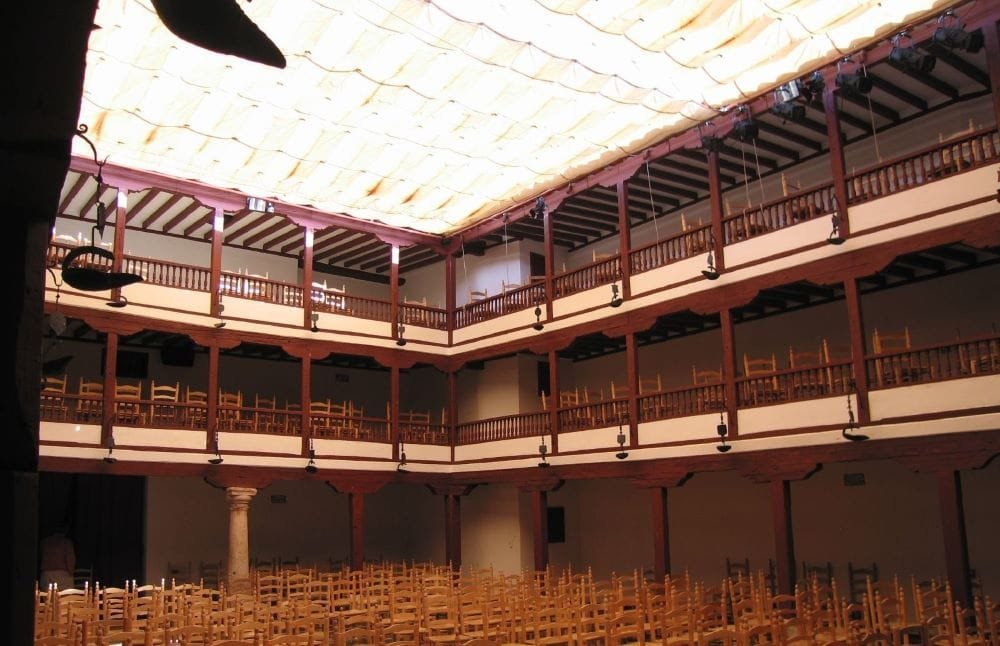
Ciudad Real – Wine, History, and a Taste of La Mancha
Just 20 km (ca. 12 miles) southwest of Calatrava la Vieja, Ciudad Real offers a mix of history and gastronomy. Founded by King Alfonso X, its highlights include the Gate of Toledo, a medieval archway blending Moorish and Gothic styles, and the Cathedral of Santa María del Prado.
But the real draw? Wine. This province lies within the Denomination of Origin La Mancha, one of the world’s largest wine-producing regions. Nearby Valdepeñas is renowned for its Tempranillo reds, best paired with Manchego cheese in a local tapas bar.
For literature lovers, the Don Quixote Museum celebrates La Mancha’s literary legacy, making it a fitting stop if you’re tracing Cervantes’ famed knight’s journey.

Bonus: Calatrava la Nueva – The Next Chapter
If you want to complete the story of Calatrava la Vieja, head an hour south to Calatrava la Nueva, the mountaintop fortress that became the Order’s grand headquarters. Perched high in the Sierra Morena, it offers breathtaking views and a fitting finale to the tale of Spain’s first military order.
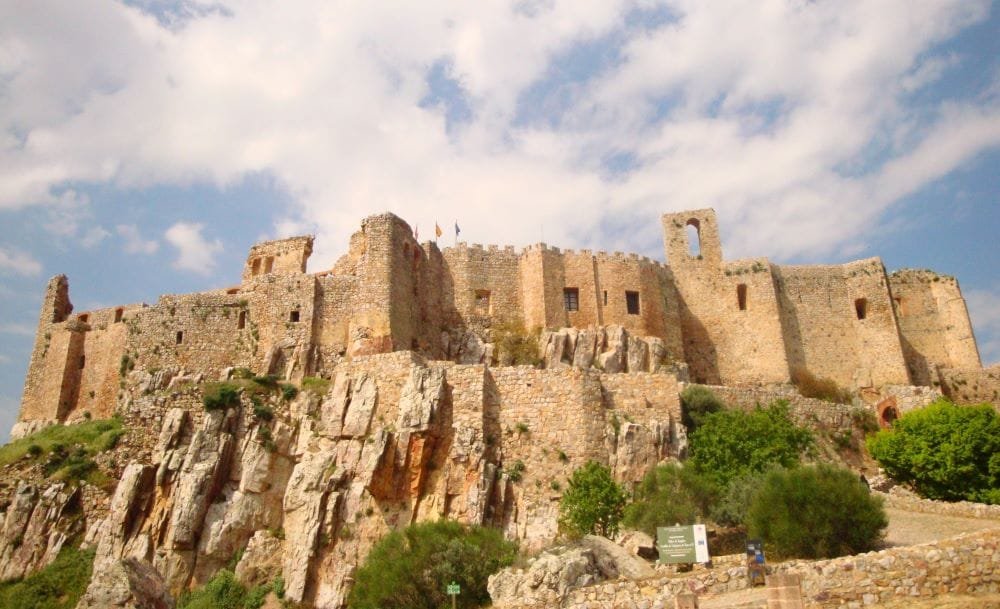
When to Go & How Long to Stay in Calatrava la Vieja
Timing your visit to Calatrava la Vieja can make all the difference, as the site is completely outdoors and exposed to Castilla-La Mancha’s extreme climate. Summers can be scorching, while winters bring solitude and misty ruins. Here’s what to expect in each season:
Best Times to Visit Calatrava la Vieja
Spring (April–May) and Autumn (late September–October) offer the ideal conditions. In spring, the fields around Calatrava la Vieja burst into wildflowers, the Guadiana River swells with winter rains, and daytime temperatures stay between 15–25 °C (60–77 °F). The mix of cool breezes, blooming thyme, and golden sunlight makes exploring the ruins feel almost dreamlike. Autumn brings milder weather, golden landscapes, and the bonus of La Mancha’s grape harvest season—a perfect excuse to pair your visit with a local wine tasting.
Summer (June–August) is a challenge. Temperatures often exceed 35 °C (95 °F), and the sun blazes down on the stone ruins. If you visit, aim for early morning or late afternoon. The site typically closes midday due to the heat. However, if you don’t mind the dry, cinematic Wild West aesthetic, summer offers stark beauty: cicadas hum, dust swirls, and the fortress radiates warmth. Just come prepared—hat, sunscreen, and plenty of water are a must.
Winter (November–February) is the off-season, with reduced opening hours. Temperatures hover around 5–15 °C (40–60 °F), and frosty mornings or rare snowfall can add an eerie, medieval atmosphere. The ruins at sunrise, wrapped in mist, make for unforgettable photos.
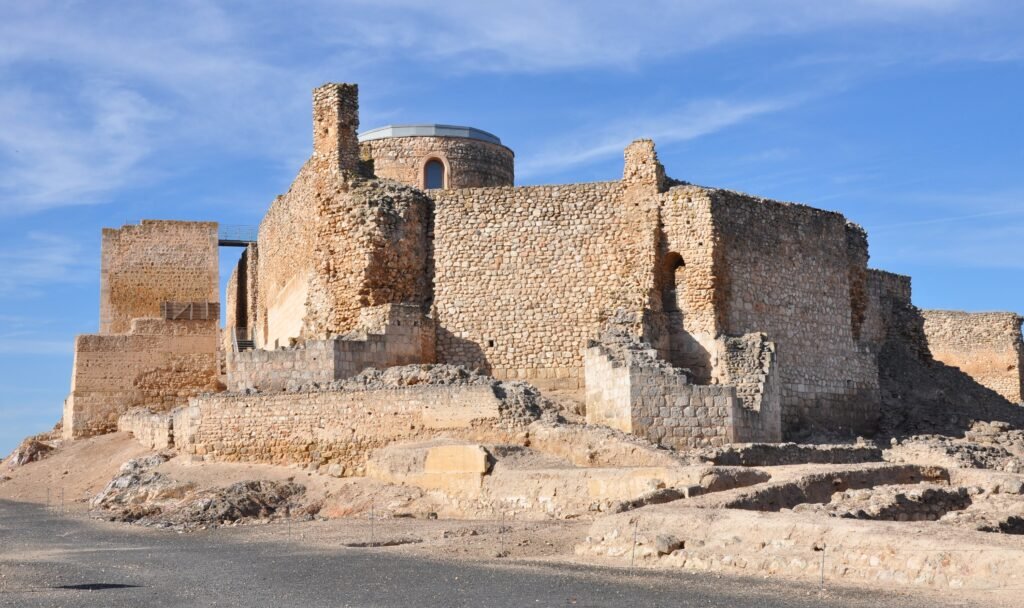
How Long to Stay when Visiting Calatrava la Vieja
A thorough visit takes 1.5 to 2 hours. History buffs or photographers may stretch it to 3 hours, while casual visitors might finish in an hour—but that would feel rushed.
For a half-day trip, pair Calatrava la Vieja with Almagro for lunch and a walk through Golden Age Spain. A full-day itinerary could include Calatrava la Nueva, the mountaintop fortress that succeeded the original. If staying overnight, consider Almagro’s Parador, a former Franciscan convent, for a historically immersive stay.
Pro tip: Visit at opening or sunset to experience Calatrava la Vieja’s changing light and quietest moments—a true journey into the past.

Final Thoughts on Calatrava la Vieja – A Journey Back in Time
As you leave Calatrava la Vieja, it’s hard not to feel the weight of time pressing against you. Here, where Moorish emirs once ruled and warrior-monks stood watch, history isn’t behind glass—it’s beneath your feet, in the rough stones of the fortress walls, in the whispers of the Guadiana River. This is no carefully restored palace, no tourist-filled castle with velvet ropes and scripted narratives. Instead, it is raw, untamed history, a place where the past lingers without interruption. Standing on the ramparts, gazing across the wide, open plains, you can almost hear the echoes of hooves, the clash of swords, the hushed prayers of knights before battle.
But Calatrava la Vieja is more than a ruin. It is a testament to resilience—to the faith that built it, the wars that scarred it, and the centuries that have yet to erase it. You’ve traced the outlines of its forgotten mosques and chapels, stood where messengers once rushed through arched gates, and imagined the fate of those who defended these walls. Unlike many sites where history is sanitized and neatly packaged, here, it remains tangible, untouched, and deeply human. Every broken arch and weathered stone tells a story not just of conquest, but of survival.
For now, Calatrava la Vieja remains a quiet relic, visited only by those who seek out history’s hidden corners. But for how long? As interest in Spain’s medieval heritage grows, this forgotten fortress may not remain forgotten much longer. Today, however, it is still yours to explore—a place where silence speaks louder than words, and the past waits for those willing to stop, listen, and remember. And when you finally leave, don’t be surprised if part of you stays behind, lingering in the golden light of Castilla-La Mancha.




